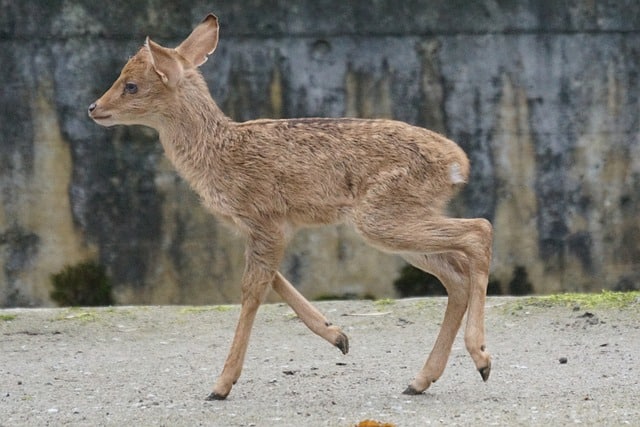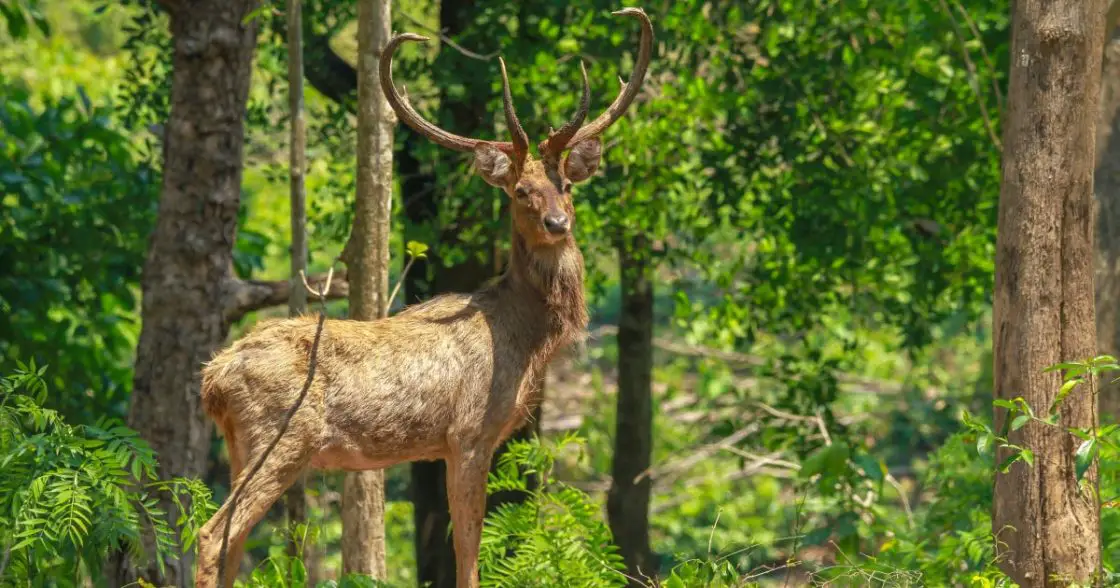Eld’s Deer (Panolia eldii) is a species that goes by many different names. These include Thamin Deer, Brow-Antlered Deer, and Cervus eldi. Though endangered, this elegant and graceful species native to southern Asia is certainly worth preserving.
On this page we will share information about Eld’s Deer. Learn this deer species‘ size, physical description, range and preferred habitat, and behavior.
How Big is the Eld’s Deer?
- Head & Body Length – 150 to 180 cm
- Shoulder Height – up to 110 cm
- Tail Length – 20 to 30 cm
- Weight – up to 150 kg
What Do Thamin Deer Look Like?
This deer is known by a number of different names, including the Brow-Antlered Deer, Eld’s Deer, Thamin and even as the Dancing Deer.
The Eld’s Deer is a medium-sized deer, similar in appearance to the Barasingha, to which it is closely related.
It is a very majestic species of deer, possessing the usual elegant Cervus stature with long thin legs, a long body and a large head on a thin neck.
Stags are larger and heavier than the females.
Coloration
In summer the coat is a reddish-brown color, while the winter coat is darker and is a dark brown.
The coat looks course and rough, especially around the throat of the males where a thick mane of longer hair forms.
Males tend to be darker in color than females.
The tail is short in length, and there is no distinct rump patch.
Antlers
The most distinctive feature of Eld’s Deer is the impressive antlers of the stags, which are many-tined and which can grow to be as large as 2 metres in length.
Most stags have antlers with 12 tines, but sometimes animals can be seen with antlers with over 20.
The antlers grow in a distinctive lyre shape; growing backwards in a long arc. Instead of growing upwards they tend to grow outwards and then inwards.
The brow tine is especially long and noticeable, a feature which contributed to this species being called the Brow-Antlered Deer.
Subspecies of Thamin Deer
There are 3 subspecies of Thamin:
- The Manipur Brow-Antlered Deer or Sangai (C. e. eldii) is found in the Manipur province of North Eastern India.
- The Burmese Brow-Antlered Deer (C. e. thamin) is found in Myanmar.
- The Thailand Brow-Antlered Deer (C. e. siamensis) is found in Thailand and China.
Where do Brow-Antlered Deer Live?
Now let’s take a look at where in the world the Eld’s Deer live, and discuss the preferred habitat of Thamin Deer.
Distribution & Range
Thamin population’s numbers and distribution range have declined dramatically over the past 200 years.
This has been partly because of over hunting, but mainly because of the deer’s habitat loss.
Originally Eld’s Deer ranged across northern parts of India and into southeastern Asia. They called the countries of India, Myanmar, Thailand, Vietnam and southern parts of China their home.
Today all three subspecies are at serious risk of becoming extinct:
- Around 200 Manipur brow-antlered Deer are found in Keibul National Park in loktak lake in the Indian State of Manipur.
- 2,000 to 3,000 of the Burmese Thamin remain in scattered locations within Myanmar.
- The Thailiand Brow-antlered Deer is found in in Eastern Thailand and on the Chinese Island of Hainan, the population numbers for this subspecies are unclear but thought to be low.
Preferred Habitat
The Thamin Deer’s preferred habitat is open parkland areas or light woodland. They like to stay near to rivers or wet marshy land. The Eld’s Deer is rarely found in thick forest or woodland.
Unfortunately, these areas are also ideal areas for cultivation. And as the human population of the Eld’s Deer’s native range has grown, so too have Thamin numbers fallen.
This species of deer has largely been forced out of their native and preferred habitat.
What Do Eld’s Deer Eat?
Thamin feed on a variety of water living plants, grasses, herbaceous plants, and shoots.
How Long do Thamin Deer Live?
Thamin have a maximum lifespan in the wild of around 10 years.
Reproduction & Mating Habits of Eld’s Deer
The Rut for Eld’s Deer takes place in the early spring months between February and May.
Males compete with each other to gain control of a harem of females that they can then mate with, a mating behavior that’s typical of many deer.
After a 220 to 240 day long gestation period, normally a single calf is born.
Thamin Deer have spots at birth. This is a form of natural camouflage, and these spots fade as the animal grows.

Does wean their young at 7 months of age, and the calves become sexually mature from 18 months of age onward.
Unique Habits & Behavior
Eld’s Deer behave in a similar fashion to the Barasingha, though few detailed studies of its behavior have been conducted.
Thamin Deer live in separate sex herds of up to 50 animals. Male Eld’s Deer join the female herds during the rutting season.
The Thamin Deer is mostly nocturnal.


